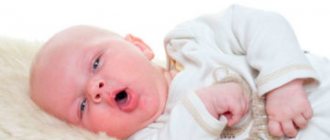Sometimes young parents notice a phenomenon in their baby when he rolls his eyes up, down or to the sides. Incomprehensible symptoms always cause concern and anxiety.
What can this condition be associated with and what to do, in what situations you need to urgently run to the doctor, and in what cases you shouldn’t give in to panic and sound the alarm - let’s take a closer look at what it is if a child rolls his eyes up.
Children roll their eyes
Parents often turn to pediatricians with the question of why their infant rolls his eyes or opens them during sleep. We need to figure out where is the norm and where is the pathology.
Newborns
During the period when a child is born, his muscular system is still very weak. The baby is not able to independently control his muscles. Newborn babies do not know how to focus their gaze, so if a similar symptom occurs in the period after birth, there is no need to panic and sound the alarm.
In most situations, eye rolling is the norm for a baby who has just been born. The baby may try to focus on an object that is located above it. Sometimes a child who is not holding his head will roll his eyes just to look the other way or behind him. And since his eye muscles are not yet formed, the eyelids can open a little on their own during sleep.
After a month, this should normally go away on its own, when the baby learns to control the movements of its muscular system. If by the age of three months this phenomenon remains, a mandatory consultation with a pediatric neurologist is necessary.
Up to a year
When a baby turns one month old, he should already be able to concentrate his vision on specific things and images, and control his eye muscles. If a child older than 1 month begins to roll his eyes, the reasons may lie in:
- improper maturation of the muscular system;
- in the absence of muscle tone;
- that intracranial pressure increases;
- such a phenomenon can be a dangerous signal of an epileptic seizure;
- Graefe syndrome may develop.
A symptom of Graefe's syndrome may also be the baby's eyes rolling downwards during sleep. Such pathologies are very rare, but if parents have doubts and suspicions, it is better to contact a pediatrician and neurologist to exclude the development of serious diseases.
Older
If such a symptom appears in children older than one year, this is not the norm. This is a sign of existing disorders in the body. For example, diseases of the upper respiratory tract or hearing organs may develop, and there may be pain in the facial muscles. Eyes roll as a result of natural reactions to stimuli - the child is simply trying to alleviate his condition in this way.
Sometimes parents notice when a child often squints his eyes and rolls them up and to the side. This most often occurs between the ages of 4 and 10 years. This is called a nervous tic. You should not scold your baby, since he cannot control such reactions of his body, and you should not ignore such symptoms.
Another cause of this symptom may be intracranial hypertension or epilepsy. In such cases, you need to visit a doctor for help as soon as possible and begin timely treatment.
What does it look like in a child?
Eye rolling, in most cases, occurs in infants when falling asleep. This looks like the iris disappearing under the upper eyelid, leaving only the white sclera visible. The eyes are half-closed at this time, but the pupil is not visible, only a white stripe.
Experienced mothers understand that when the pupil begins to creep upward, the child is ready to fall asleep and begins to doze. Although it often looks like the baby is grimacing and smiling. Sometimes the eyelids remain slightly closed during sleep, leaving only the whites visible. Some parents get scared and think that the baby is ill, as it looks like rolling his eyes when he loses consciousness.
For newborns, such eye movements are within normal limits.
Until what age is it normal to fall asleep?
Eye movements are carried out by a whole group of muscles, which, like all other muscles in the baby’s body, are in their rudimentary form at birth.
The movements of the arms and legs are chaotic, and the newborn is not yet able to regulate them. The eyes are a paired organ; controlling their movement is even more complex.
Therefore, in newborns, temporary strabismus is often noticeable, which gradually goes away with strengthening of the muscles.
When a baby falls asleep, he completely loses control over his fragile muscles. Up to 90% of babies under the age of one month roll their eyes. The nervous system gradually improves, muscles become stronger, the child begins to focus his gaze and follows objects.
Pediatricians believe that in infants the upward movement of the pupils when falling asleep during the first 2-3 months is within normal limits.
Help: it is important that the baby does not show signs of anxiety, gains weight, develops and eats well.
In what cases should you consult a doctor?
Eye rolling at an early age is not an abnormal behavior, but if it does not stop after 2-3 months, it is time for parents to worry. Deviations in the state of health and alarming signs of illness can be judged by a number of symptoms and characteristics of the infant’s condition.
Sleep disturbances or frequent crying
A newborn can communicate all worries, pains and inconveniences only by screaming. Frequent crying, reaching the point of hysterics, when the baby twitches and cannot calm down for a long time, indicates serious problems. Another alarming sign is poor sleep, inability to relax or fall asleep soundly.
Eye movements are not coordinated
Anxiety should be caused by erratic movements of the pupils, their movement in different directions, not only upwards, when falling asleep. Unnatural twitching and uncoordinated eye movements should be reported to your doctor.
The head often throws back
A tilted head in a baby may be a sign of certain diseases.
Developmental delay
Developmental delays - insufficient weight gain, inconsistency with other age norms - should be a cause for concern.
Jaw trembling
Jaw twitching may be a sign of the development of neurological or endocrine disorders in an infant.
Strabismus
Strabismus becomes noticeable in the first months of life and requires timely treatment.
Very rapid and asymmetrical head growth
A disproportionately growing head may be a physiological feature and gradually straighten out or require serious treatment for hydrocephalus.
Vomiting, nausea
Frequent regurgitation and vomiting are a sign of an underdeveloped digestive system in a newborn. Sometimes they indicate the development of dangerous diseases.
Problems with nutrition and feeding
If the baby does not eat well, regularly does not meet age-appropriate feeding standards, or the sucking reflex is poorly developed, you should consult a pediatrician.
Motor coordination disorders
The baby must gradually learn to coordinate his movements - pull the arms, follow the object with his eyes, turn his head towards the sound. If coordination is impaired, nervous system disorders may be diagnosed.
Increased body temperature
A dangerous sign is an increase in temperature. This is a reason to urgently call a doctor without trying to knock it down yourself.
How parents can help their babies
The main task of parents is to carefully monitor the condition of the newborn and pay attention to additional symptoms other than eye rolling. If the baby is cheerful and gaining weight well, there is no reason to worry.
You should tell your doctor about your concerns during visits and medical examinations. An examination by an ophthalmologist and a neurologist is carried out at 1 month; specialists should tell about all the signs that seem alarming to the mother.
If necessary, additional examination and treatment will be prescribed.
Important: medical examinations should not be ignored. During the examination, specialists will dispel worries or promptly diagnose a dangerous disease.
Therapeutic measures
If the baby is growing and the eye rolling continues, the doctor may prescribe therapeutic measures to strengthen the muscles. Diagnostic tests are usually performed when several warning signs are present or when the child is more than 3 months old. The eye muscles are strengthened without drugs using exercises and physical therapy.
Gymnastics for the eyes
The simplest exercises for the eye muscles are carried out for infants in the form of a game. The baby is taught to focus his gaze while following a toy. To do this, choose a bright rattle and slowly move it in front of your eyes, drawing attention to it.
It is important that the baby is healthy, well-fed and in a good mood at this time. The distance is changed, teaching the child to find the object and not look away. It’s worth playing with your baby until he gets tired.
This will be a complete workout for the eye muscles.
A mobile phone that is great for independent training attracts kids with a variety of bright objects and teaches them to independently choose an object to observe.
Massage and physiotherapy
Massage has a general strengthening effect and increases muscle tone in the baby. It is important to find a good specialist who knows how to work with infants. A special eye massage strengthens the eye muscles and improves coordinated joint movements of the eyeballs.
Self-massage will not give the desired result. Parents can invite a massage therapist to their home or visit a clinic. If there are indications, other physiotherapy procedures are prescribed - therapeutic baths with soothing phytocomplexes, physical therapy exercises for muscle development, reflexology.
In what cases can it be a symptom in infants?
Parents, together with doctors, must determine in time when eye rolling is not a physiological feature of young infants, but indicates the development of pathologies. An alarming sign is that the baby is already more than 3 months old, but the rolling of the eyes does not decrease; it occurs not only before falling asleep, but also while awake.
Intracranial pressure
Increased intracranial pressure in an infant is characterized by many signs, including rolling and protruding eyes. Hypertension can be suspected by a disproportionate increase in head size and severe anxiety in the infant, as he suffers from headaches.
ENT disease
Severe diseases of the nasopharynx (also otitis media) can negatively affect the eye muscles and provoke their weakening. As a result, the rolling of the pupils of an infant may last longer than physiological norms.
Graefe syndrome
Eye rolling may be a partial or isolated manifestation of Graefe syndrome, caused by excess cerebrospinal fluid in the brain. In this case, rolling up is called Graefe's symptom.
It is characterized by the movement of the eyeballs down to the lower eyelid, slight mobility of dilated pupils. In this case, the baby throws his head back. Usually the muscle condition returns to normal by 6 months.
Epileptic seizure
Eye rolling may be a warning sign of the onset of epilepsy. In this case, the child suffers from convulsive movements and has increased muscle tone. During sleep, short-term pauses in breathing may occur, and the baby turns his head sharply and frequently.
Muscular dystonia
Increased or decreased tone of the eye muscles, causing the pupils to roll back, may be a sign of muscular dystonia. This is one of the syndromes of central nervous system damage.
Diagnosis and treatment
If eye rolling in an infant is accompanied by additional symptoms, behavioral disorders, poor growth and development, the doctor will prescribe diagnostic tests. Conducted:
The baby is examined by a neurologist and ophthalmologist. Based on the research results, treatment tactics for identified neurological or ophthalmological diseases are selected.
Possible reasons
The main provoking factors of nervous tics include:
- Emotional stress. For example, during a change in the usual environment, when the baby goes to kindergarten or school. Such changes cause severe emotional stress in some children. A nervous tic can be provoked by hostility from a teacher or teacher, or conflicts with peers.
- Another common reason for this condition is conflicts at home between parents in the presence of the child, or when excessive demands are placed on him. In this case, he is in constant fear and anxiety, his body reacts with such twitches.
- Genetic predisposition. This factor is very significant.
- A long course of taking certain medications, complications after illnesses.
- Head injuries.
- Staying in a stationary position for a long time, for example, in front of a computer monitor or holding a phone in your hands.
- Incorrect, unbalanced diet, which is dominated by fats and hard-to-digest carbohydrates.
In this case, contacting a neurologist is mandatory.
Another cause of disorders in the eye organ is the problem of intracranial pressure in the baby. Additionally, vomiting and vision problems occur. Such manifestations should not be ignored.
And another dangerous cause of eye rolling is epilepsy. It appears in seizures, body twitching, head shaking, and convulsions. Additionally, there is loss of consciousness, throwing back of the head, strong clenching of the jaws, breathing slows down, and involuntary emptying of the bladder and intestines may occur. After an attack, the child seems to wake up and does not remember anything that happened to him.
The work of the eyes and visual muscles of a newborn
From the first days of life to one or two months, children are not yet able to regulate the coordination of their arms and legs. In addition, almost all systems and organs, including visual ones, are underdeveloped. During the neonatal period of life, the muscles that control the eyes work imperfectly and very often incorrectly coordinate the motor function of the eyeballs.
All newborn children, in addition to underdeveloped oculomotor muscles, still have a fairly small size of the eyeballs, incompletely formed fiber, and the interaction of the visual nuclei in the brain with the optic nerve is not developed. This can be easily tracked by certain signs: a baby in the neonatal period is not yet able to focus his gaze on any individual objects.
Parents may notice that their child rolls his eyes a few minutes (or even seconds) before falling asleep. When the baby is on the border between sleep and wakefulness, the baby's eye muscles relax. It is at this moment that the pupil enters under the upper eyelid.
Sometimes the baby rolls his eyes or starts to squint a little during active sucking. This happens because the baby’s still very weak body directs all its forces to the process of obtaining food and is not yet able to control the eye muscles.
At the end of the 1st or beginning of the 2nd month of life, the toddler begins to gradually focus his gaze on certain things and objects. He already recognizes the faces of mom, dad and all the relatives living next to him in the same apartment.
Important! Parents should closely monitor their child; if in one month he still rolls up his pupils, he should urgently seek advice from a doctor. You may have to go through a series of studies to identify pathology.
Newborn baby
What to do
The main thing that parents need to do is to calm down themselves. Don't panic. If eye rolling in newborns is no longer accompanied by any symptoms, this is normal, everything will go away after a month.
If this phenomenon occurs in older children, under no circumstances should you engage in any independent treatment or give medications to the baby. It is best to contact a pediatric neurologist who will make the correct diagnosis and, if necessary, prescribe treatment.
Recommendations for improving the condition
If parents notice a decreased tone of the muscles of the child’s visual organs, they should:
- Exercise with your baby every day, why use bright objects and educational toys for games. They will help the proper development of vision.
- Sign up with your child for swimming lessons, baby massages and physiotherapeutic procedures.
- Buy baby rattles of various bright colors; they will help develop not only vision, but also hearing, and will also contribute to better concentration.
Additional Information. If there are neurological disorders in young children, independent use of nootropics or vitamins for brain activity is unacceptable. A neurologist can make a diagnosis and prescribe appropriate subsequent treatment and recovery.
In most cases, such a phenomenon as a child's eyes rolling upward is not a pathology or a symptom of any serious disease. This is an absolutely normal manifestation for newborns, since they are not yet able to control their oculomotor muscles.
When should you not worry?
In most situations, rolling the eyes upward in children does not signal the development of a pathological process. This phenomenon is observed in newborns.
As the baby gets older, this symptom will go away on its own. If parents are in doubt, they should consult a specialist.
When should you visit a specialist?
You should definitely see a doctor if your eye rolling is accompanied by the following symptoms:
- sleep disturbances, increased anxiety;
- it is impossible to concentrate your gaze on an object;
- increased excitability;
- frequent tilting of the head back;
- delay in mental, physical or mental health;
- jaw twitching;
- signs of strabismus;
- asymmetrical head shape;
- attacks of vomiting and nausea;
- lack of coordination;
- hyperthermia.
Up to what age
In order to answer this question, it is enough to recall the physiology and developmental features of newborns. Doctors say that the process of training the eye muscles begins approximately from the moment the baby reaches one month of age. It is then that he will be able to focus his gaze on a particular object, thereby strengthening his muscles. Add a couple of months directly to the training itself and you will get the exact answer.
In general, pediatricians say that there is no need to worry about this until the child reaches 3 months of age. If, after this time, the problem with eye rolling in a newborn remains, most likely it was caused by other reasons. Needless to say, an accurate diagnosis in this case can only be made by a qualified specialist.
Associated symptoms and what they indicate
Sometimes eye rolling is a sign of a malfunction of the internal organs:
- a paroxysmal tonic upward gaze may be detected, which is inherited, is a complication of infectious processes, and can provoke deviations in the development of the baby’s psyche;
- if there are ENT diseases, additional pain, stuffy ears, lumbago in the ears, and fluid leakage occur;
- with epilepsy, there is additionally a lack of reactions to stimuli and tilting of the head;
- with increased intracranial pressure, strabismus, vomiting, and hyperthermia additionally appear.
Doctor Komarovsky's opinion
If there are additional symptoms, Komarovsky advises the following diagnostic methods:
- Consultation with an ophthalmologist;
- Magnetic resonance imaging (MRI);
- Neurosonography;
- Computed tomography;
- Neurosonography through the fontanel.
The well-known pediatrician also states that rolling the eyes does not always signal the presence of diseases of the central nervous system or increased pressure inside the skull. In babies under three months of age, this pupil movement is normal. Parents have nothing to worry about.
Komarovsky also advises paying attention to additional symptoms in infants:
- Active enlargement of the head on one side;
- Frequent attacks of vomiting;
- Non-fusion of sutures on the skull;
- Poor appetite;
- Fear of loud sounds and bright lights;
- Marked anxiety;
- Additional signs of meningeal pathology.
The baby lies and looks
The child rolls his eyes up, to the side, down
When the baby's eyes roll up, everything is fine with their health, but only if there are no additional symptoms. If the eyes roll downwards, this already indicates the development of certain disturbances in the functioning of the internal organs.
This is often the first sign of intracranial hypertension. Also, rolling to the side or down can signal the development of Tourette's syndrome, nervous tics, other nervous manifestations, and Graefe's symptom.
It is important not to ignore such symptoms in children older than one month. Contact neurologists in a timely manner and be examined for the presence of pathologies.
Causes of eye rolling in babies
The following factors provoke upward rolling of the pupil:
- prematurity;
- injuries to the baby during labor;
- infectious lesions of the mother during pregnancy;
- Hypoxia is common;
- hereditary predisposition.
If your eyes roll downwards, you should visit a neurologist, as the baby may develop Graefe syndrome. Additional symptomatic signs of pathology are:
- not expressed reflexes;
- convulsions;
- problems with swallowing;
- weakness of muscle fibers;
- strabismus.
The syndrome develops against the background of weakening of the ocular muscles, which occurs due to the accumulation of cerebral fluid in segments of the brain.
How to treat?
If a newborn baby rolls his eyes, throws his head back and constantly cries, then it is necessary to carry out treatment after identifying the source of the problem. When the disorder is provoked by a neuroinfection, medications of various effects are prescribed. Sometimes pathology manifests itself against the background of excessive intake of drugs or toxic substances, in which case such treatment must be canceled. When the baby rolls his eyes in the first days of life, then in order to normalize visual function and improve the functioning of the visual organs, it is necessary to regularly work with him, using bright toys and objects. With frequent training, the child quickly learns to focus his vision and control his eye muscles, due to which the rolling goes away.
No less important for pathology is special gymnastics, which is prescribed by a doctor to older patients. It includes the following classes:
Gymnastics for the eyes helps strengthen the muscles of the organs and improve the functioning of the visual apparatus.
- frequent blinking;
- rotational movements of the eyeballs clockwise and counterclockwise;
- strong closure of the eyelids and relaxation.
For children who experience eye rolling, a relaxing massage is recommended, as well as activities in the pool. It is possible to cope with the disease through physiotherapeutic procedures. If the problem of rolling the eyeballs is associated with a nervous tic, then it is important to provide the baby with peace and avoid stress and overwork.
First aid for an epileptic attack
When a baby rolls his eyes during an epileptic seizure, parents should remain calm and not panic so that they are able to help the child. The baby should turn his head to the left or right to prevent the tongue from retracting and to facilitate the passage of saliva. Under no circumstances should you open clenched teeth with your fingers or other objects. It often happens that after an attack the child falls asleep, so you should not wake him up. If your eyes roll back as a result of epilepsy, it is recommended to consult a doctor as soon as possible, since with each new seizure the patient’s condition worsens, which negatively affects psychomotor and mental development.
How to make the whites of your eyes whiter
Many people consider the white whites of the eyes to be an indicator of beauty and health. But in most eyes, the sclera is reddened and has a yellowish-gray tint. First you need to make sure that there are no chronic diseases of the liver, kidneys and metabolism, and only then try to give the ideal whiteness to your eyes.
It is impossible to whiten the visual organs like teeth, but eye drops that constrict blood vessels can improve the situation somewhat:
All these medications quickly eliminate inflammation and irritation. The whites become almost perfectly white, and the red blood vessels disappear. But it is worth considering that such medications can only be used for a short course. All of them are addictive, due to which the effect is greatly reduced.
You can get rid of redness and yellowness using a number of folk recipes:
- Tea brewing helps a lot. It contains tannins that have a beneficial effect on the visual organs.
- You can brew chamomile and lemon balm. This decoction has a strong anti-inflammatory and calming effect.
- Apply slices of fresh cucumber to your eyelids for 20 minutes. You can grate the vegetable on a fine grater, add a little water and pour the resulting mass into ice cube trays. In the morning, rub the area around the eye sockets with ice cubes.
- Freeze the chamomile decoction and wipe the eyelids with cubes several times a day.
It’s definitely worth reconsidering your lifestyle. In some cases, a good rest is enough for the condition to return to normal.
You should avoid using medicinal herbs if you are allergic to plants.
Diagnostic procedures
If a child shows signs of illness, you should immediately contact a specialist to identify the causes of the deviation. If a child lowers his eyes down or constantly rolls them up, while turning his head strangely, you should immediately see a specialist. Such manifestations may signal a serious violation. The specialist performs a visual examination of damaged visual organs. To make an accurate diagnosis and find out the cause of the problem, you need to undergo a comprehensive examination, including laboratory tests and hardware diagnostics.











